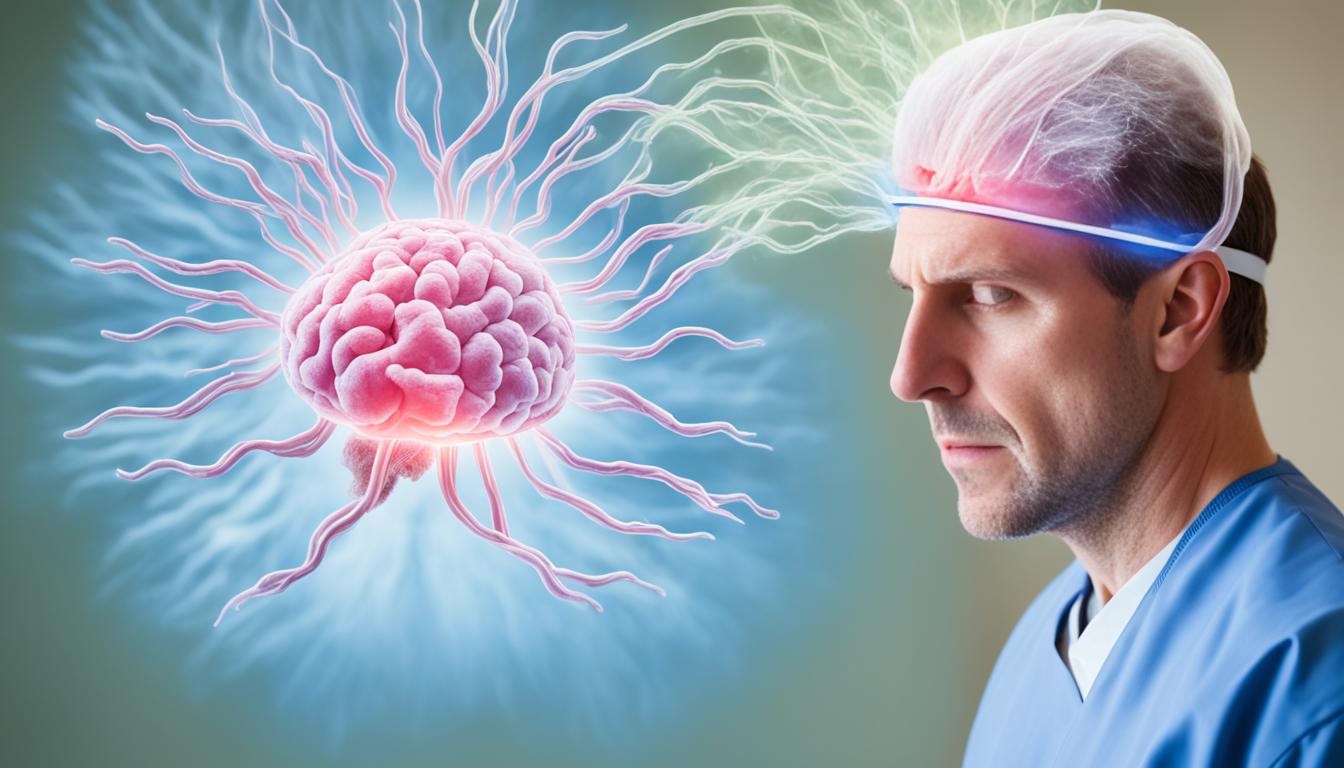Prolactinomas are benign pituitary tumors that make too much prolactin hormone. They are most often found in women, making up half of all pituitary tumors. Older teens to young adults are usually affected, with women being at a higher risk than men.
The main signs include high prolactin levels in the blood, leading to unusual milk production (galactorrhea). It can also cause periods to stop (amenorrhea), making it hard to get pregnant (infertility). Men might face a lack of interest in sex and problems with the reproductive system.
Doctors use tools like MRI scans to spot prolactinomas. Treatment often starts with drugs that lower prolactin levels. But, surgery might be needed in more severe cases. Now, stem cell therapy is also being looked at as a possible way to treat prolactinomas.
Key Takeaways
- Prolactinomas are common benign tumors that secrete prolactin hormone.
- They are most frequently diagnosed in women of reproductive age.
- Main symptoms include hyperprolactinemia, leading to various reproductive system issues.
- Diagnosis involves imaging tests such as MRI to visualize the pituitary tumor.
- Treatment options include dopamine agonists and surgical intervention if necessary.
- Stem cell therapy is an emerging treatment option for prolactinoma.
Epidemiology and Pathogenesis of Prolactinoma
Prolactinomas are the most common type of pituitary adenomas. They vary in how they spread and start. Knowing what leads to their growth helps doctors handle and treat them.
Epidemiology of Prolactinoma
The where and how often of prolactinomas is its epidemiology. They mostly happen alone, with few linked to family mutations. Women of child-bearing age get them more, making up most cases. There are five to ten women with prolactinoma for every man with it.
The reasons for this are not all clear. Things like hormones and genes might play a part. It’s been noticed that people in Asia have more prolactinomas than those elsewhere. This suggests the problem might affect different ethnicities in unique ways.
Also, specific genetic changes are seen in some prolactinoma cases. The MEN1 gene is one known to be involved. This hints that genes could make some people more likely to get prolactinomas.
Pathogenesis of Prolactinoma
The ways that prolactinomas start and grow are what pathogenesis is about. Most are not linked to family history. But, some gene changes can cause both family and non-family cases.
Other than the MEN1 gene, genes like PRKAR1A, CDKN1B, and AIP can also be involved. They point to the role of genetic changes in starting prolactinomas. Yet, we still don’t fully know how these changes do their work.
Estrogen, a hormone important for making babies, also seems key. It makes the cells linked to prolactinomas grow more. This could be a big reason why prolactinomas develop.
Scientists are hard at work studying how genes, hormones, and more come together to cause prolactinomas.
| Epidemiological Factors | Pathogenic Factors |
|---|---|
| * Prolactinomas are most commonly diagnosed in women, with a female to male ratio ranging from 5:1 to 10:1. | * Sporadic monoclonal neoplasms |
| * Higher incidence reported in the Asian population | * Genetic mutations (MEN1, PRKAR1A, CDKN1B, AIP) |
| * Estrogen plays a role in lactotroph tumorigenesis |
Diagnosis and Management of Prolactinoma
To diagnose a prolactinoma, doctors check your prolactin levels in the blood. They also do tests like an MRI to see the tumor in the pituitary. These tests show the tumor’s size and where it is.
The main way to treat prolactinoma is to use medicines to control symptoms and shrink the tumor. Dopamine agonists like cabergoline and bromocriptine are often used. They lower prolactin levels and help the tumor to get smaller. These drugs are usually very effective and are often the first choice for treatment.
Sometimes, if drugs don’t work or if the tumor is big, surgery might be needed. Surgeons take out the tumor to help with symptoms and to stop future problems.
Managing prolactinoma means also dealing with issues like pregnancy, fertility, and psychiatric disorders. Doctors and patients make a plan together. This plan looks at what each person needs based on their situation.
New stem cell therapy could be a future treatment for prolactinoma. Scientists are studying how to use stem cells to slow down tumor growth. This research offers hope for those who don’t do well with usual treatments.

